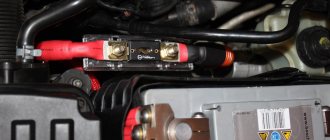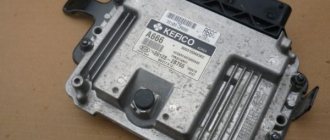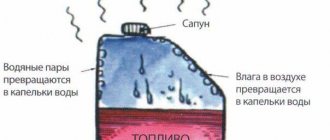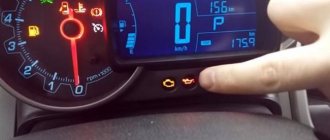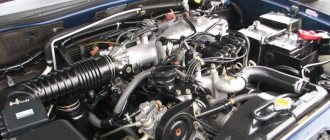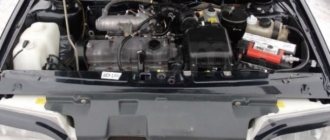Starting the engine from another battery
This technique is safer, since not the entire car is involved in the procedure, but only the battery. Therefore, most drivers agree more readily to such assistance.
However, despite the ease of starting machines using this technology, precautions must be taken to avoid serious troubles
Actually, the instructions themselves for lighting a problem car using another battery:
- The donor's car needs to be turned off.
- The power source is disconnected from the on-board network of the donor vehicle by disconnecting the terminals. If necessary, the battery is removed from the engine compartment.
- On the recipient, the ignition must be set to zero, after which the negative contact from the negative terminal is disconnected
- Now both batteries are connected to each other as follows: the working plus is connected to the positive terminal of the discharged battery. The same with the minus - from a working battery to a discharged one. In this case, initially both “crocodiles” cling to the working battery.
- When you touch the negative terminal to a discharged battery, sparking may occur. There is no need to be scared - this indicates that the recharging process has begun. After connecting the wires, you should check their reliability.
- Wait at least minutes for the discharged battery to recharge a little.
- After waiting, you can try to start the recipient engine. In this case, the wires remain in the specified position. Even if the battery is deeply discharged, the engine should start without problems.
- Once the engine starts, it needs to run for a few minutes to further recharge its own battery.
- Turn off the engine and remove the wires from both batteries.
- Re-introduce a recipient. If everything is in order, the job is done and the donor should return his battery and also start it.
You should not light a car using this method on frosty days at temperatures below −25 C. And also if the electrolyte is frozen.
How to light a battery?
Correct jumper wires!
Motorists do not have a unanimous opinion about lighting the battery. Many people consider this process quite undesirable and even dangerous. However, the approaching winter makes lighting up extremely important. A dead battery is a familiar problem for many. There is simply nothing to recharge quickly, and starting the engine “from the pusher” can be very difficult. For cars with automatic transmission, this method is not applicable at all. Therefore, the only source of current to start the engine is another car whose battery is normally charged. Thus, the approach of winter makes lighting up extremely important, no matter how you feel about it.
How to choose a wire?
One of the first points to start repairing leashes is choosing a wire. More precisely, it is worth deciding whether to use a cable or a wire. In fact, the difference between the two in terms of performance is barely noticeable. Often it all depends on how the manufacturer himself positions his product.
Cable, cord and wire are concepts that are often confused with each other. According to textbooks, a cable is several separate cores isolated from each other, united by one solid insulation. For example: VVG (copper cable in PVC sheath and PVC insulation), which can have from one to four cores. In different cables, the cores have different cross-sections.
A wire can also have several separate cores isolated from each other, united by one solid insulation. For example: PPV (Flat Copper Wire with PVC insulation) or PUNP - two and three cores with a cross section of 0.75 - 4 mm².
The cord has approximately the same structure, only the current-carrying conductors are flexible because consist of a bundle of thin wires, and covered with a more flexible insulation and protective sheath. For example: PVC (copper wire with twisted conductors in PVC braid) with a cross-section from 0.5 to 2.5 mm².
In addition, you should remember that it is better to use copper cable for wiring in the apartment. This will increase the reliability of the wiring, and consequently reduce the likelihood of a fire. That is why such electrical wires for a wooden house are the best solution. Everyone knows that wood itself is more susceptible to burning. This means that the risk of fire is higher when compared with an apartment or a stone house.
When choosing, you should also consider the material from which the wire is made. If it is made of aluminum, then it is endowed with less conductivity of electricity and quickly begins to break in places of kinks. In addition, the wire oxidizes, and this oxide has increased resistance. This means that the quality of current conduction will only deteriorate. The main advantage of such wires is their relatively low cost.
Copper wires have significantly better qualities, for example:
- They are not as susceptible to oxidation.
- Conduct current better.
- More adapted to the external environment.
- Not so prone to breakage at bends.
At the same time, the cost of wires is slightly higher compared to aluminum ones. But such an expense pays for itself. Due to the quality of copper wires, wiring will have to be changed much less frequently.
The electrical cable in the apartment should be flexible enough. Typically, city wiring has a large number of connections and bends. If we are talking about cables used outside a residential apartment, then such flexibility will no longer be required from them.
Selecting wires for lighting
On sale, including at gas stations, there is a wide selection of wires for lighting a car. Since such a purchase is not made for one day, it is better to purchase a universal, reliable model that will last for many years.
Next, read the main recommendations and what parameters you should use to choose them.
Length
Do not try to buy wires of the maximum length. The longer the conductor, the more the voltage across it drops. If at 1 meter of conductor the voltage drop is 0.5 Volts (at high starting currents this is possible), then at 3 meters the drop will be 1.5 Volts. Considering that there are two wires (positive and negative), the total voltage drop will be 3 Volts. If the donor car’s battery has 13 Volts, then only 10 Volts will reach your own car, which may not be enough for a stable start.
The length of the wires depends on the installation location of the standard battery. If the battery is located in the passenger compartment or trunk, there must be a powerful terminal under the hood to start the car in emergency mode. It is usually located under the red insulating protection and is indicated by a “+” symbol.
The normal universal length of the cigarette lighter wires is from 2.0 to 3.5 meters.
To ensure that they are enough to light a car in the garage, experienced drivers place the car with the hood facing the gate. If the battery is located under the hood on the passenger side, the length of the wires for lighting should be longer, since it is likely that it will be more problematic for the donor car to drive close to the location of the battery, especially on the highway.
Cross-sectional area of the wire for lighting a car
The minimum cross-sectional area of the current-carrying wire is 16 sq. mm. In terms of diameter, this is about 5 millimeters (half a centimeter). Wires with a smaller cross-section will heat up and have a large voltage drop across them.
Chinese manufacturers save a lot on wire cross-section. In pursuit of reducing costs (copper is very expensive), they significantly reduce the thickness of the cores, trying to hide this fact behind the large thickness of the insulation. It is better to purchase wires from Russian manufacturers. A cross-sectional view of a Chinese wire that is not of the best quality can be seen in the picture below.
Material of wires, insulation and alligator clips
Typically, current-carrying conductors are made of copper stranded conductor. Copper also comes in different qualities and production technologies. For example, speaker wires are manufactured using seven different technologies. For lighting wires, the technological features of the manufacture of conductors are insignificant, so they use a more budget-friendly quality.
Aluminum has a lower resistivity, and from this point of view it is better suited for conductors. But there are two significant disadvantages: it is brittle and fusible, so it is not used in factory-made cigarette lighter wires.
The insulation is usually made from soft polyvinyl chloride (PVC). It is difficult to judge its quality by its appearance. The packaging may indicate the operating temperature range. At temperatures less than minus 30 degrees Celsius, poor PVC insulation can crack, rendering the wires unusable.
Alligator clips can be made of steel, copper, brass, bronze. The best option is undoubtedly copper or brass. In the case of steel, there will be greater contact resistance on different materials, electrolysis processes increase (the wires become covered with a green or white coating). Bronze, especially thin bronze, is more brittle. There are good combination clamps made of steel with copper “teeth”.
Average price category
MegaPower M-30030
The main point that immediately catches your eye is the length of the wires - 3 meters. The delivery set is quite standard, it includes the jumper cables themselves and a compact bag for storage and carrying. It is quite comfortable, with a zipper, and equipped with a nylon handle. The wires themselves, together with the clamps, are made of copper and have a rather interesting external design. The clamps are quite large, their handles are multi-colored: black ones connect the negative terminal together, red ones are used for the positive one. The handles are made of high-quality rubberized materials and do not fall off even after several years of use.
The springs of the clamps are reliable and elastic, made of high-quality steel. The insulation is made of silicone, which allows the wires to be used at temperatures down to -40 degrees. The maximum starting current is 300 A.
Advantages:
- The braid withstands low temperatures well;
- High quality clamps;
- Sufficiently long cables;
- The wires can withstand currents up to 300 A.
Flaws:
- The quality of the case leaves much to be desired.
Jump leads MegaPower M-30030
Airline SA-400-01
It is distinguished by even greater power compared to the previous model - the cables are able to withstand a maximum current of 400 A, and even in this case they will not heat up excessively, the products are designed for a completely standard voltage - 12 V. The cables retain their performance characteristics in the temperature range from - 35 to +80 degrees.
The length of the wires is 2.5 m, the clamps are made of durable steel, coated with a layer of copper. They are compact in size - they can be used even in the most inaccessible places. Their handles are made of plastic, but they are quite soft and do not slip off conductive elements, which minimizes the likelihood of electric shock when working with wires. The conductive elements have a cross-section of almost 16 square meters. mm, cable diameter is 9 mm.
Advantages:
- The braid is quite soft and does not become wooden in the cold;
- Crocodiles have elastic plastic pads;
- The optimum ratio of price and quality.
Flaws:
- Crocodiles are not completely copper, but only copper-plated;
- The wires are carefully crimped, but not soldered.
Starting wires Airline SA-400-01
AVS BC-500
In use, this model is characterized by reliability and durability; the wires can be used alone if you have a charged battery at hand. For greater safety, the wire clamps are well insulated - even careless touching of conductive parts is completely excluded. The contact connection areas are well thought out by the manufacturer, so the recharging process will become even simpler and easier.
The cables can operate even at very low temperatures: from -40 to +80 degrees. The maximum inrush current that can pass through such cables is almost a record 500 A. A convenient zippered bag is supplied with the cables. Each wire contains 210 copper cores, which in total give a cross-section of 16.88 square meters. mm. The wire winding is made of thermoplastic rubber. Even if the conductive elements become very hot, the braid will not melt and will retain its basic qualities.
Advantages:
- Excellent production quality;
- Powerful and carefully isolated crocodiles;
- Decent section;
- Passes current up to 500 A;
- Reliable braid that can withstand both low and high temperatures.
More: Top 10 best towbars, how to choose the right towbar for a car?
Flaws:
- Crocodiles are made from copper-plated aluminum.
Jump leads AVS BC-500
Airline SA-500-04
Equipped with compact clamps that ensure reliable fastening and maximum tight contact of the wires with the battery terminals. The product is completely insulated, which prevents electric shock. The highest starting current is 500 A at an operating voltage of 12 V.
The diameter of the braid is 9 mm, it is made on the basis of high-quality silicone, which allows the wires to withstand very low temperatures. The cores are made of copper, the cable length is as much as 5 m, and even in this case, voltage losses will be minimal, and the lighting process itself will become even more convenient. The set is packed in a bag fastened with a zipper. The wires have 270 cores each, they give a combined cross-section of 19.1 square meters. mm. Operating temperature range from -40 to +80 degrees.
Advantages:
- Decent length of conductive cables;
- Significant throughput current;
- Crocodiles are compact, but very reliable;
- The insulation is soft, but quite durable.
Flaws:
- Some users still find the price a little high, despite all the advantages of these cables.
Starting wires Airline SA-500-04
Bezmenovsky quarry
Recommend a place
22
3
Bezmenovsky quarry is a small lake located in the east of the Moscow region, in the city of Balashikha. The lake is very popular among locals and is a wonderful picnic area.
Another name for the Bezmenovsky quarry is Lake Kozlovo. This reservoir is located on the territory of the so-called Lake Forest Park. The views here are amazingly picturesque - the lake is completely surrounded by forest, and the banks are overgrown with grass. This is a great place to relax in nature. At a distance of just a few hundred meters from the Bezmenovsky quarry there are other lakes - Yushina and Baboshkino.
In summer, the water in the quarry warms up enough for swimming. This reservoir is also very popular among fishermen - crucian carp, perch, pike and roach are found here. In addition, in the forests surrounding the quarry, a lot of wild life has been preserved - hares, squirrels, martens and others.
Overall, Bezmenovsky Quarry is a great place to come for a weekend and relax on the beach. And although we are not talking about comfort, the beautiful nature compensates for all the shortcomings.
Additional information and myths
Connecting the minus to the engine housing
A common question among car enthusiasts is: is it possible to light a cigarette while the car is running? There is a very definite answer to this - NO! This is strictly not recommended. Let's try to explain why...
The fact is that at the moment the engine starts, switching processes occur, the result of which is a significant current jump. When the engine is turned off, only the battery is involved in the circuit. If the engine is running, then the generator and all other current consumers (including expensive computers and other electronics) are connected to the circuit. And for them, sudden surges in current and voltage are very harmful, as they can damage them.
When “lighting up” the donor car, it is advisable (but not necessary) to remove the negative terminal from the battery. This will ensure complete isolation of the electrical circuits of the two cars from each other.
Remember that you cannot ask the owner of the first car you see for a “light.” Ideally, the capacity of the donor battery should be no less (that is, equal or greater) than the capacity of the recipient battery. Otherwise, there is a risk of complete discharge of the donor, and even its failure. And at the same time, most likely, you will never start your car. In other words, you can “light up” a small car from an SUV, but vice versa, you can’t!
You should also not “light” a battery that is heating up, emits a strong acidic odor, or has leaked electrolyte.
It is not recommended to “light” from old or discharged batteries. Therefore, if your colleague driver refused your request, arguing that his car’s battery is old, then you need to treat this with understanding.
Starter for battery
Today, car dealerships offer devices for emergency starting of batteries, so-called starters. They are an analogue of “power banks” for electronic gadgets. “Lighting” from them is simple and safe.
Another common myth is that you can’t “light” a car with an electronic control unit (ECU). Actually this is not true. If the engines of both cars are turned off, then there is no danger to the electronics. The only thing you should remember, and what we have already mentioned, is that you absolutely cannot “light” a car with the engine running.
Why did the battery die?
Before telling you how to “light” a battery from another car, it’s worth explaining why it discharges quickly.
Among the reasons:
- deposition of lead sulfate on the plates, which reduces the battery capacity (due to frequent discharge “to zero”, poor quality electrolyte, high current charging);
- short circuit of plates having different polarities (among the reasons: crooked plate lattice, build-up on the electrodes or sludge at the bottom of the battery);
- shedding of the active mass from the plate;
- problems with the electrolyte (decrease in level due to water consumption, density not meeting the norm).
It turns out that the most common cause of battery problems is exhausted battery life. The easiest way to check this is with a special device - the so-called load fork, which simulates engine starting. In a “resting state,” the voltage on a working battery should be at least 12.7 volts, which corresponds to 100% charge. After 5 seconds under load, this value should not fall below 10.2 volts. If in a calm state the battery gives the norm, but after loading the test can no longer be passed, get ready to buy a new battery, otherwise you will soon have to ask to “light” the car.
How are typical commercially available jumper wires constructed?
Let's look at a typical cigarette lighter cable costing from 500 to 1500 rubles with a stated rated current of 400-600-1000 amperes. They almost all look like this:
Such starting wires consist of copper-plated tin crocodiles, as well as wires with a cross-section from 2.5 to 4 squares. At the same time, the wires have abnormally thick insulation - obviously, this is done with the aim of deceiving the buyer (an attempt to show that the cross-section is actually larger than it is). The insulation usually consists of PVC with a high content of plasticizers. The wires are attached to the crocodiles by pressing with brackets covered with insulated handles.
Naturally, there can be no talk of any current of 600 amperes (or even 100!). Such cigarette lighters are only suitable for lighting batteries that are not very low. Or it is necessary to charge the battery of the acceptor vehicle for a long time (for many hours) with low currents.
Let's take a closer look:
The crocodile design does not inspire confidence - everything hangs loose. The “crocodiles” themselves are made of copper-plated sheet metal with a very small contact area (in fact, the “crocodile” is in contact with the battery terminal only with the thin side surface of one clamp).
The copper strands of the wire are pressed against the surface of the “crocodile” in a bundle (as in the photo below). At the same time, the wire itself is insulated. they press the staples inside the crocodile handle (unfortunately, I didn’t take a photo of the fastening, but take my word for it - it’s just terrible). Due to poor quality wire, the cores and insulation are easily frayed, as can be seen in the photo:
Now let's look at the negative wire in cross-section. Nearby, for comparison, is a PuGV wire with a cross-section of only 10 mm2, which is used for assembling apartment panels with currents of up to 63 amperes. Absolutely most of the Chinese wire is occupied by hypertrophied insulation, and the cross-section of copper is approximately 2.5-3 square.
Is it worth throwing money at such junk? After all, it is obvious that such a design will not withstand even a current of 100 amperes (or even 50!).
Such starting wires are only suitable for “lighting up” slightly dead batteries.
Unnamed 1
If you comply with the basic requirements, then this method of starting the engine will be absolutely harmless. In particular, you can act as a donor only if your battery is fully charged, otherwise both batteries will be discharged. Particular care should be taken when lighting a cigarette in rainy weather, when a short circuit is possible. In severe frost, you should light a cigarette only if your car is warmed up. It is also important that both batteries have the same voltage. However, the main requirement is to use the correct wires.
When starting an engine from the battery of another car through the wires, good contact is very important. Therefore, the starting wires must have special alligator clips. The clamps must provide a large contact area with the terminals. One of the main requirements for starting wires is a low resistance level. Therefore, they must have copper conductors of a sufficiently large cross-section (at least 16 mm2), as well as the minimum possible length. Another key component of the wires used to connect batteries is high-quality insulation with good elasticity and temperature resistance. The insulation should not tan or crack in the cold, nor should it melt upon contact with hot surfaces, for example, a car manifold.
Scheme for lighting from another car
All motorists know that a car must have a working and fully charged battery. However, not everyone, especially beginners, follows this rule.
Hence the need to light the car early in the morning in the cold, when the starter strains to pull the overrunning clutch and cannot even engage the flywheel crown. Such troubles can happen even with a new battery. Therefore, motorists should know how to properly start a car from another battery in the donor car.
Lighting diagram for a passenger car
If we are talking about passenger cars, then connecting a charged battery to a car with a dead battery is done in the following sequence:
- connect the positive terminals of the batteries with a wire (red);
- connect the black wire to the negative terminal of the donor machine;
- the second end of the black wire is connected to the ground of the recipient's car.
Lighting diagram for trucks
On trucks, the on-board network is designed to be powered by 24 V, so two 12 Volt batteries are installed there, connected in series. Lighting for trucks follows the same pattern as for cars.
Start the car using the jump starter
If you do not want to look for another car to light your car if the battery is low, then you can purchase a starting device with which you can start the car, even with a dead battery.
There are many similar devices for starting cars on the Russian market. There are models that require some time to recharge a dead battery. There are also some models that allow you to start the car without first charging the battery.
Wires for starting the engine: what they should be and what to pay attention to
Let's start with the fact that in our separate article we have already described the subtleties and nuances of safely lighting a car with a dead battery from another donor car. Now let's move on to the wires themselves, since this issue is a separate topic.
First of all, these cigarette lighter wires have several names. Many car enthusiasts know them under the following “everyday” names: cigarette lighter wires or crocodiles. In this case, the most correct and accurate name would be starting wires.
The main task of such wires is to effectively transfer the starting current from the charged battery on the donor car to the discharged battery of another car.
It is important that current losses during its transmission through wires are minimal
It turns out that the best way to cope with this task is wires that have low resistance and allow you to achieve the smallest voltage drop. It is well known that the resistance in a wire directly depends on the material of manufacture, its length and the cross-section of the wire.
As for the length of the wires for lighting, you need to take into account that this length should be enough to connect the discharged battery to the donor battery without removing the batteries.
In this case, the important point is that the longer the wire is, the higher the resistance will be and this will inevitably begin to affect the transmission of inrush current. Taking into account the above, it should be taken into account that the starting wires must be at least 2 meters, but also no more than 4.
Another nuance is the insulation of wires and fasteners to the battery terminals. Insulation must be implemented using materials that remain elastic at low temperatures and do not break down at high temperatures. For example, silicone rubber copes well with this task.
If we talk about fasteners (crocodiles), it is important that the contact surface with the terminals is as large as possible, and that the fastener itself is securely fixed to the battery terminal. It is highly desirable that the “crocodile” itself is also copper
You also need to pay attention to how the wire is fastened to the crocodile. It is optimal when the wires are soldered and not screwed or held in place due to the presence of clamps, clamps, etc.
Budget options
AUTOVIRAZH AV-911200
They are distinguished by their low price, but quite decent quality. With their help, you can almost instantly start a car engine from the battery of another car, simply from a charged battery, or start it through a jump-start charger. The maximum starting current is 200 A. The length of the wires is significant - as much as 32 m. On the one hand, this is very convenient, because cars can be at a decent distance from each other, but the voltage losses are quite large.
More: Top 10 best friction tires for a car, how to choose Velcro?
The cables are supplied with a storage bag made of synthetic materials. This solution is very convenient - the wires will not be scattered throughout the trunk. The operating temperature of these wires ranges from -25 (at lower values the likelihood of damage to the wire insulation increases) to +60 degrees.
Advantages:
- The cable is flexible;
- The products are of decent length;
- The set includes a synthetic cover;
- Acceptable price.
Flaws:
- The wire is not very thick, so it cannot withstand too high a current.
Starting leads AUTOVIRAZH AV-911200
Airline SA-150-07S
The ends have very reliable and tight alligator clips. They come into the most intimate contact with the battery terminals and start the engine literally within one to two seconds. The length of the wires is only 2 meters, so the cars should be parked as close to each other as possible, the highest throughput current does not exceed 150 A, the cables are designed for a voltage of 12 V. The products are optimally suited for use in extremely cold winter conditions. The conductors are placed in frost-resistant insulation, which can withstand temperatures up to 40 degrees below zero.
The wires are made on the basis of copper stranded cores - there are as many as 80 of them in the structure. Their total cross-sectional area is 6.6 square meters. mm, which is a very serious parameter.
Advantages:
- Very high-quality cable insulation, which can easily withstand even quite severe frosts;
- The clamps are reliable, contact the terminals very tightly;
- Provides quick lighting.
Flaws:
- They are able to withstand low current, so such wires are suitable only for relatively weak engines.
Starting wires Airline SA-150-07S
AUTOSTART AS-P200-22
Although this product belongs to the budget price category, many users praise it in their reviews, since its quality and capabilities clearly exceed its cost. First of all, the wires are insulated from polyvinyl chloride materials with the addition of silicone. These substances can easily withstand very low temperatures (down to 50 degrees below zero) without deformation; cracks do not appear on the insulation even after several years. The conductive element consists of 80 copper strands that are intertwined.
Crocodiles are quite tight - in order to unclip them you will have to apply a decent amount of force. They fit securely to the battery terminals. The maximum starting current reaches 200 A, the cable is designed for 12 V, but the length is insignificant - only 2 m.
Advantages:
- Wire insulation can withstand severe frosts;
- Capable of passing optimal current through itself;
- The clamps are of high quality and connect tightly to the terminals.
Flaws:
- The length of the wires is short - you have to park the cars literally close to each other.
Jump leads AUTOSTART AS-P200-22
Airline SA-200-02
These wires are able to instantly start the engine regardless of weather conditions - they are designed for use at temperatures from -40 to +80 degrees. The starting current is 200 A. The terminals are compact in size, just like the conductive elements, they are made of high-quality copper - a material with minimal resistance to electricity. The small dimensions of the terminals help to get close to the battery, which is located in a hard-to-reach place under the hood of the car.
The operating voltage is quite standard - 12 V, the length of the wires is short (2 m). The set of wires comes in a reusable silicone case - it is convenient to store this product. The instructions are detailed and tell you in clear language how to use these cables correctly. The cross-section of the current-carrying conductors is 8.5 square meters. mm.
More: Top 10 best cabin filters
Advantages:
- An excellent option for car engines whose volume does not exceed 2 liters;
- Crocodiles are made from high quality copper;
- The insulation is very soft and can easily withstand very low temperatures.
Flaws:
- The zipper on the case fails quite quickly;
- At maximum current, the wires heat up excessively, which ultimately leads to a voltage drop.
Starting wires Airline SA-200-02
Honest manufacturer
While it is quite possible to independently understand the technical side of the choice, it is quite difficult to determine the quality of the purchased product.
To buy a high-quality cable for wiring in an apartment, you need to pay attention to the following points:
- Marking quality. The inscription on the wire must be clear, clear and easily readable.
- Insulation color. It is standard solid. In rare cases, there is a black stripe along the entire length. The presence of stains, streaks or additional patterns indicate a low-quality product.
- Package. Cables are always packaged in coils or drums. Each package comes with a tag containing detailed information about the product.
- Certificates. The quality of the material can be checked by asking for documents - certificates of conformity and fire safety are attached to the cables.
- Appearance. Often damage and dents indicate poor transportation and storage. Bends, compression, and abrasions can hide internal damage.
How much do car ignition wires cost?
Chinese wires for cigarette lighter for Airline car
The best in the tests, AVS and AIRLINE, cost 300-400 rubles, while HEYNER, which turned out to be second according to the test results, costs 4,000 rubles. It is difficult to say unambiguously which of the tested wires for lighting a car turned out to be the best - none of the tested kits are suitable for frequent use. In general, none of the test kits was without flaws. For some, the crocodiles do not hold well on the battery terminals; for some samples, the insulation is generally cracked and burnt. As a result, when the problem of cold engine starting is especially acute, car owners make their own wires for lighting batteries.
How to make cigarette lighter wires with your own hands
If store-bought wire options are not to your liking or are expensive, then it is possible to make them yourself. It’s easy to make them if you have wires of the right cross-section, the right length, and crocodile clips for the terminals.
Where to get the wires
The best wire you can get for lighting a car is the wire from a welding machine. Nowadays, many people have compact welding machines; you can take them from there or buy them separately.
The insulation of the welding wire is rubber with silicone. Inside there is a copper, stranded wire. If the HL marking is stamped on the rubber, this means that it can be used in severe frosts.
For starting wires, welding wires with the code KG will be used. Cut 6 meters of wire in half. The main thing is that the diameter of the wire core is at least 9 mm.
Where to get crocodiles or how to make them
You can make clamps from copper welding holders. Be sure to insulate the handles. But, the best option for starting car wires are store-bought factory alligators.
Their cost is not high. We buy 4 pieces. When purchasing, check that the teeth clamp well, or, if toothless crocodiles, then that the clamping force is normal.
It is better to take it with a reserve of current strength. That is, if you take 500 Amperes for the wires, such clamps will last a long time. If you have a truck, it is better to take 850 Amperes.
Putting it all together
So, you have two pieces of wire and four clips of different colors. You will need a sharp knife to strip the ends of the wire and some plastic zip ties. Attach clamps of the same color to one of the wires. Using tightening ties, tighten the fastening of the wire in the clamp. Repeat this procedure with the other wire. That's all - now you have your own wires for lighting.
With your own hands you have assembled an indispensable accessory for the winter road. It should be noted that high-quality frost-resistant wires cost about 1,600 rubles. When collecting wires for lighting, you will spend on average the following amounts:
- welding cable with a cross-section of 25 mm, length 5 meters - 710 rubles;
- four clamps for connecting ground, a total cost of 400 rubles.
In total, your reliable and high-quality cigarette lighter cables cost you 500 rubles less than those offered in car stores.
Having spent very little time, you will be absolutely sure that these wires are reliable and will always be able to help if necessary.
Now you can not only help yourself out in a difficult situation, but also help your friends or other road users.
Unnamed 2
One of the most notable new products on the modern market of automobile accessories is the starting wires of the BERKUT brand, SMART POWER series, model SP-400. They have characteristics that are most suitable for lighting batteries:
- length - 3 meters;
- core cross-sectional area - 16 mm2;
- high-quality frost-resistant insulation of current-carrying conductors, which can be operated at temperatures down to -45 degrees;
- significant contact area and pressing force of the “crocodiles”, as well as their reliable insulation.
These characteristics make it possible to ensure efficient and safe starting of the engine from the battery of another car. But the greatest advantage of the SMART POWER SP-400 jumper cables is the presence of a diagnostic module. This is a special electronic unit with LED indication that controls operating parameters. The diagnostic module checks the battery charge level and the health of the generator. In addition, the diagnostic module will warn you about polarity reversal when connecting the wires to the battery terminals.
How to properly “light” a car from a donor: step-by-step instructions
After the appropriate wires for “lighting” have been purchased, you can begin the procedure itself. It's time to learn how to properly “light” a car from another car.
Preparing for “lighting up”
“Lighting up” should be done in stages, and initial preparation is carried out. To do this, perform the following steps:
Both cars must be located at a sufficient distance so that the wires are long enough to connect them. Connecting the wires must be done with the donor engine turned off.
Both vehicles must have the parking brake in place, the gear shift levers in neutral, and the ignition turned off. When connecting wires, it is important to observe polarity. The red wire is for the plus terminal, and the black wire is for the negative terminal.
Before connecting the wire clamps to the donor battery, you need to make sure that the second ends of the clamps do not touch each other and do not lie on the body of the second car. This will lead to a short circuit and damage to the donor car's battery. Before carrying out the “lighting up” procedure, you need to make sure that the voltage on both batteries is the same value (6, 12 or 24 V).
Carrying out the terminal connection procedure
The wire connection diagram is as follows: the red wire clamp is connected to the plus terminal of the donor battery, and its other end is connected to the positive terminal of the recipient battery. Similarly, connect the clamp of the black wire to the negative terminal of the donor battery, and the second end of the black wire to the metal body (block) of the engine (closer to the starter)
It is recommended to connect each wire separately to avoid a short circuit when the second clamps of the red and black wires come into contact.
It is important to take into account that the black clamp is not connected to the negative terminal of a discharged battery. Please note another important point: when starting the engine, the pulleys and fan will rotate, so the black wire must be positioned so that it does not come under the influence of these elements
This clamp should also be located as far as possible from the fuel system, since the slightest spark can lead to ignition.
After this, the engine of the donor car is started. Let the engine run for at least 5 minutes to recharge the battery. Consider the ambient temperature conditions. The colder it is outside, the longer you need to let the engine run. To speed up charging, you can increase the number of revolutions to 2-3 thousand.
Test run of the engine
While the engine of the donor car is running, the dead battery is recharged. The longer the period of recharging time (engine operation), the higher the likelihood that the recipient’s motor will start the first time.
- When you are ready to try to start the engine on a car with a dead battery, you need to turn off the engine on the donor vehicle and turn off the ignition.
- The ignition on the second vehicle is turned on, and we try to start the engine. If the engine does not start, then a second attempt can be made only after the donor vehicle has recharged the battery. You need to let the engine run again for at least 10 minutes.
- After a second attempt, the engine should start. If this does not happen, then repeat the charging procedure again. Once the engine is started, you can disconnect the wires.
First you need to disconnect the black wire, which is attached to the negative terminal of the recipient battery. Next, the second clamp of the black wire from the donor battery is disconnected. The red wires are removed in a similar sequence. Experts say that there is no difference in the sequence of disconnecting the wires, the main thing is to disconnect the negative (black) wire first.
The sequence of removing the wires after “lighting up”: the most important thing is to disconnect the negative wire first
As soon as the engine of a car with a dead battery is started, there is no need to turn it off. Now you should let the battery recharge, so try not to turn off the engine for 30 minutes. If, after recharging the battery, an attempt is made to start, but the starter turns and the engine does not start, this means that the recipient’s car is faulty. It is necessary to carry out diagnostics and identify the cause of the engine malfunction.
How to light a car correctly?
Every driver should have the skill to light the battery. It would seem that there are no problems with this, because there is plenty of information on the Internet. But if you ask five people how to light a battery, you will get five different answers. Many answers will be partially correct, but not completely. We offer you the right way to light a dead car battery.
Before you start lighting a dead battery, you need to have a few things ready. The first thing you need is high-voltage wires for lighting. Second, you need a car with a normal battery charge level.
Therefore, we advise you to carry wires in your car, which may be useful to you if you want to help some driver who cannot start his car. In addition, high-voltage wires will come in handy in case the battery in your car is dead. The fact is that not every driver carries such wires with him, and you will not need to look for them to light your car.
Before lighting the car, make sure that the high-voltage cables are in good condition. They should be long enough to reach the other car. Remember that the wires should not be exposed, and the rubber protective coating should not be cracked or damaged. The connecting terminals must be clean, free of carbon deposits and oxides, as well as the battery contacts of both vehicles.
ASTRO SMART PLU
A distinctive feature of the model is the safety clamps, thanks to which you will definitely not receive an electric shock in the event of polarity reversal or contact shorting. This not only makes the operation of the devices as safe as possible, but also prevents overloading the vehicle's electrical system.
Special LED indicators indicate whether you have connected the wires to the terminals correctly. The ends are connected separately, so that even if the cables touch, a short circuit will not occur.
The devices are capable of transmitting 400 A. The thickness reaches 6 millimeters, the length of the wire is 5.3 m. The service life reaches 10 years. This is not as much as in the case of conventional wires, but still quite good.
Mid-price segment products
Autoprofi APBC5000XL
The length of the wires for lighting is 3.5 meters. It is very convenient to use for charging batteries in both trucks and cars. Operates in severe frosts and hot weather. Does not break or crack. Lasts quite a long time. The clamps are durable and high quality.
The average price is 1550 rubles.
wires Autoprofi APBC5000XL
Advantages:
- ease of use;
- optimal length;
- positive reviews;
- value for money;
- safety.
Flaws:
- none.
Battery Vympel 146227
The product is produced by a Russian enterprise. The current indicator is 500 A, length 3 meters with a diameter of 10 mm. Consists of 94 cores. Designed for operation at temperatures from 50 degrees below zero to 80 degrees above zero. It is safe and has a long service life. Made from quality materials.
The purchase price is 1,794 rubles.
battery wires Vympel 146227
Advantages:
- ease of use;
- durability;
- functionality;
- versatility.
Flaws:
- not installed.
Stels 55919
The product is manufactured to perform this task - to additionally recharge the starter in a vehicle if its own battery is completely dead or the oil has frozen in severe frost. The length of the product is 2.5 meters, it operates with a current of 400 A. It will become an indispensable assistant for starting cars and trucks.
Purchase price – 1330 rubles.
wires Stels 55919
Advantages:
- versatility;
- practicality;
- functionality;
- durability.
Flaws:
- none.
Astro Smart PLU
The model is in great demand due to its complete safety and reliability in operation. Even if a polarity reversal or contact shorting occurs, the driver will never be shocked due to the presence of safe clamps. If an emergency occurs, there will be no negative impact on the electrical systems. The manufacturer has equipped its brainchild with special LED indicators that will let you know whether you have connected the wires to the terminals correctly. The ends are connected separately, so even if the cables touch each other, a short circuit will not occur. Capable of passing a current of 400 A. The thickness of the cores is 6 mm. The wire is 5.3 meters long. The manufacturer guarantees a service life of 10 years.
Purchase price – 1300 rubles.
Astro Smart PLU wires
Advantages:
- safety;
- reliability;
- versatility;
- functionality;
- positive user reviews;
- value for money.
Flaws:
- not installed.
Safety precautions
Precautions must be taken when transferring charge from a working vehicle to an idle one.
Safety rules:
- Do not light the car with the engine running. Although that's what they usually do. But modern cars are crammed with electronics and it would be a shame if all the electronics burned out. Moreover, the electronics can burn out in both cars. The donor car runs for 5-10 minutes at speeds up to 3 thousand.
- Next, you need to turn off all electrical appliances (radio, headlights, etc.).
- Maintain polarity. We do not allow short circuits. If the connection is incorrect, that is, plus a mine, not only the electronics can fail, but the insulation of the wires can also catch fire. Therefore, a fire extinguisher should be nearby.
